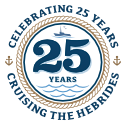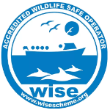Much of the scallop produce on sale in Scotland is dredged and the problem with dredging is it lacks discrimination. Towing 1 tonne of heavy dredging gear through the seabed leaves it like a ploughed field killing much of the life on the seabed and destroying the complex benthic habitat. Hand diving for scallops is best for the environment and for flavour – we only ever serve hand-dived scallops on board.
Hand diving for scallops is a sustainable method of fishing; the diver hand picks the scallops from the seabed leaving the smaller undersized scallops to grow and spawn. There is no waste or bycatch. Our owner and Skipper of Hebrides Cruises, Rob Barlow is very passionate about the way we source our shellfish and makes sure that it has not come at the expense of the marine environment. We also use the Ethical Shellfish Company on Mull as a supplier of scallops with Guy Grieves and Rob having dived for scallops many times together. Hebrides Cruises is also linked to ‘OpenSeas’, an organisation promoting and committed to protecting our marine environments. We are an ethical company and all our food on board is sourced locally and sustainably.
Eat Hand dived Scallops on board!
Rob has not only been diving for scallops since 1976 but has also “shucked” many over the years. He shows our guests his quick and easy way to clean ‘clams’ as they are known locally on the West Coast of Scotland. Its even a quicker and easier way than chef Gordon Ramsay!! Here is one of our Chefs, Pip’s favourite recipe.
Pip's 'rough & ready' scallops
It's all about the taste here. The recipe can be doubled, trebled or quadrupled. On a good day the Skipper can bring up 80 little beauties! It's a very good-humoured recipe and the end result never fails to make the guests happy.
Ingredients – serves 4
- 12 hand-dived scallops (or as many as you can eat)
- A couple of splashes of olive oil
- 1 onion, diced
- 1 fat garlic clove, finely chopped
- Small glass of good white wine (buy a bottle & enjoy the rest)
- 4 rashers of smoked streaky bacon, thinly sliced
- 200ml double cream (you can also use crème fraîche)
- A good bunch of roughly chopped curly parsley
- Sea salt & cracked black pepper
Add the olive oil to a frying pan over a medium heat. Once hot, add the diced onion and cook gently till softened, not coloured. Add the finely chopped garlic & cook for a further 2 mins, moving the onions & garlic around the pan to avoid them catching. Remove the onions & garlic with a slotted spoon and put to one side. Add the sliced bacon to the pan and fry till golden. Add the onions & garlic back to the pan with with bacon and pour in the white wine. Allow it to bubble & reduce until just a few spoonfuls remain in the pan. Turn off the heat while you cook the scallops.
Place a separate non-stick frying over a medium-high heat and add a dash of olive oil. Once the pan is hot add the scallops - starting a 12 o'clock and working clockwise around the outside of the pan. They should give a satisfying sizzle. Once all the scallops are in the pan flip over the first scallop you placed in the pan and work clockwise again, turning over the remaining scallops. The scallops want to have good caramelisation - leave unturned for a further 10 seconds or so before flipping over to the other side. Squeeze a little lemon juice into the pan and a knob of butter and let it slide around the pan to coat the scallops (the gentle motion of the waves usually does this for me!)
Whilst the scallops finish cooking place the onions & bacon back onto a medium heat. Add the cream and heat through. Don't let it boil - just a gentle simmer - or it will thicken. If this does happen just add a little more cream to loosen. Add the chopped parsley and a good pinch of black pepper. Taste before adding any salt.
Place all the scallops up on a serving plate (straight out of the pan is better!) and serve the sweet garlicky cream sauce on the side. Pass the plate round and get stuck in.
Enjoy!























Hi Emma - Thank you we had a fantastic time and its probably the best holiday we have ever had. We couldn’t fault the boat or the crew in any way and the only worry we have is that the bar has been set so high its difficult to know how to reach it never mind beat it again. However we will be back to cruise with you again as it was so good. I have to mention the crew we had, they were all, without exception, absolutely brilliant . Having Hannah with her knowledge and enthusiasm was a real bonus and as my wife is the real wildlife fan it made it for her, she spent so much time up on the bow with Hannah and a couple of the other guests I thought she wouldn’t come in for meals sometimes. However the draw of Mags meals did bring her in and it was excellent. I don’t know if we were lucky with the guests but everyone got on very well and it made the whole trip very enjoyable. Thank you so much for giving us such a fantastic experience.
K McKechnie: 1 July 2024St Kilda and the isles of the Outer Hebrides